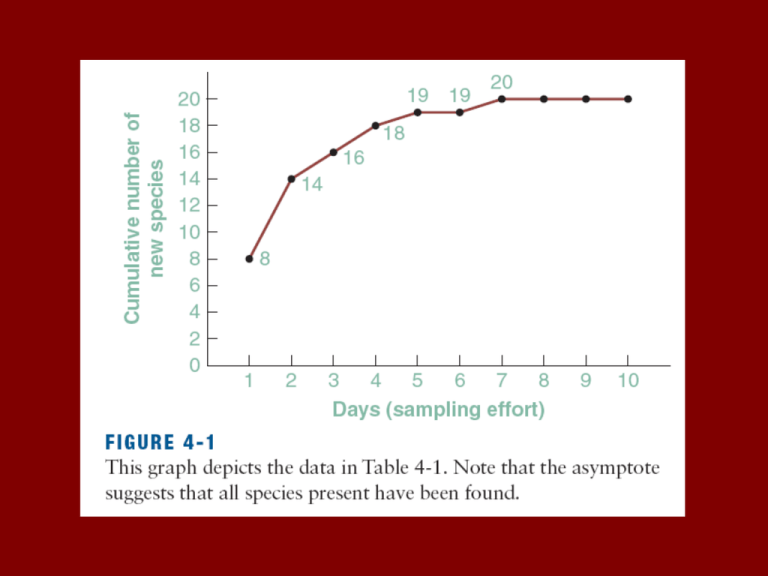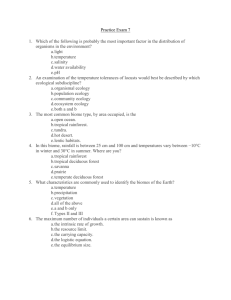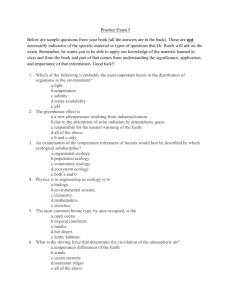Slides: Chapter 4: Inside Tropical Rain Forests: Biodiversity
advertisement

FIGURE 4-5 This graph is based on a calculation called the Sorensen similarity index between pairs of 1-hectare plots as a function of distance between the plots and is thus a measure of beta diversity. Note that similarity among plots declined most rapidly in Panama and more gradually in Ecuador and Peru. PLATE 4-1 This rain forest in Trinidad contains a high species richness of trees, birds, arthropods, and other taxonomic groups. FIGURE 4-6 The relative abundance of various plant families at Barro Colorado Island. FIGURE 4-7 The relative abundance of various plant families at Manu floodplain forest in Amazonian Peru. PLATE 4-4 This anuran inhabiting the forest floor in a lowland Panamanian forest is one of 164 anuran species found in Panama. PLATE 4-5 The butterfly Philaethriadido (family Heliconiinae) is found widely in lowland forest in Central and South America. PLATE 4-8 GOLDEN-MANTLED TREE KANGAROO FIGURE 4-15 These maps, based on four vertebrate classes (mammals, birds, reptiles, and amphibians) show (a) species richness compared with (b) species endemism. Note the prevalence of both richness and endemism in tropical regions. The numbers on the scale are proportional indices of abundance. FIGURE 4-16 On this map, the darkest areas are regions that collectively represent about 10% of Earth’s terrestrial surface but that include 56.5% of vertebrate endemics and 61.6% of all species. The lighter regions, in orange, added to the darkest regions represent 50% of the terrestrial Earth and account for almost all species of vertebrates. FIGURE 4-17 This graph depicts the relationship between time since splitting and average absolute midpoint latitude for sister tax a of New World birds (left) and mammals (right). The oldest divergence dates (in millions of years ago) cluster strongly toward equatorial latitudes. FIGURE 4-20 A comparison of the cladograms generated by ITS compared with trnL-F analyses. Note that many differences are evident, but divergence times are nonetheless quite rapid in each case. FIGURE 4-23 The bars depict the importance of energy compared with water. As to which of these primary variables best explains animal species richness as it varies with latitude, energy best explains richness for high northern latitudes, but water best explains richness in equatorial and lower latitudes. FIGURE 4-26 The upper graph depicts the per capita extinction rate (for plants) through the early and midCenozoic, while the lower graph shows the per capita origination rate. There is an increase in extinction at the Eocene–Oligocene transition (upper graph), and the lower graph shows a slow decline in origination over time. FIGURE 4-27 These are all of the kingfi sher species found in all of tropical South America. All fi ve species—pygmy, green, Amazon, green-and-rufous, and ringed—often occur in the same area. FIGURE 4-28 These 11 kingfisher species are found in Kenya, but no more than 5 are found in any given area. FIGURE 4-30 This cladogram shows that the temperate and tropical tree species of comparable phylogenetic distribution support similar numbers of folivorous insect species. The cladogram represents 14 tree species from Moravia (temperate zone) and Papua New Guinea (tropical), with branch lengths proportional to the number of nucleotide substitutions in rbcL sequences. PLATE 4-19 This spider, part of the arthropod litter community, preys on other arthropods (mostly insects) in the litter layer within an Ecuadorian lowland moist forest. FIGURE 4-32 This amazing array of small flycatchers (Tyrannidae) are all found in Venezuela. Those most similar usually do not occur together in the same habitat. Note the differences in body size and bill characteristics. FIGURE 4-33 Compound checkerboard exclusion shown in three Melidectes honeyeater species in New Guinea. No region supports more than two of the three species. FIGURE 4-34 Two New Guinea warbler species, Crateroscelis robusta and C. murina, do not overlap altitudinally. Note that the highest relative abundance of each species occurs where they meet. The left side of the figure represents actual birds recorded, while the right side graphs relative abundance of each warbler in the entire bird community. The two species replace each other at 1,643 meters, where each species reaches its maximum abundance. PLATE 4-21 Miconia produce fruits used by numerous bird species, many of which, like manakins, spread seeds. Miconia belong to the Melastomataceae family. PLATE 4-22 The white-bearded manakin (Manacus manacus) is a common disperser of Miconia seeds. PLATE 4-23 The Neotropical eyelash viper (Bothriechis schlegelii) is one of many predatory species whose collective influence may affect diversity patterns in tropical forests. PLATE 4-26 COLLARED PECCARY (PECARI TAJACU) PLATE 4-27 These two roosting fruit bats (Chiroderma spp.) are among the many species of Chiroptera that occur in the Neotropics, where it is estimated that 39% of all mammals in Neotropical forests are bats. From Ecuador.




